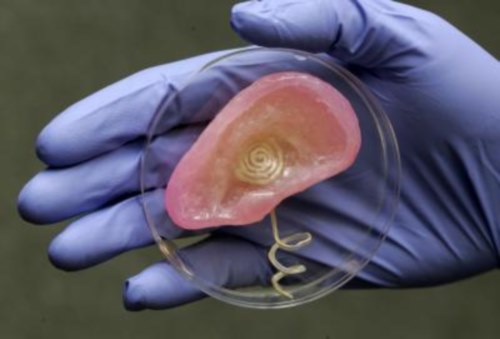The 3D printing boom has been changing the medical field
in recent years. Engineers have discovered ways to print
viable organ tissue and mini organs that have the potential
to impact drug and surgical testing as well as save lives.
One group of engineers took organ printing a step further
and set out to merge electronics and biology by printing a
fully operational ear.

The 3D-printed bionic ear capable of
recieving radio signals. (Image credit: Frank Wojciechowski)
Researchers at the Princeton
University School of Engineering used a 3D printer to
create a functional ear that can actually “hear” radio
frequencies. Not only does their printed ear actually
work, but it works so much better than a normal human ear
that the team calls it a bionic ear.
In the past, research groups have attempted to combine
electronics and biology by using a 2D sheet of electronics
and a surface of the tissue.
“Our work suggests a new approach — to build and grow the
biology up with the electronics synergistically and in a 3D
interwoven format,” said Michael McAlpine, assistant
professor of mechanical and aerospace engineering at
Princeton and lead researcher of the team.
Last year, McAlpine made some progress involving the use of
small-scale medical sensors and antennae when he developed
"teeth tattoos” composed of biological sensors and
antennae affixed to the surface of a tooth.
McAlpine and his team (which even included a high-school
student that mastered CAD designs of bionic ears) were
interested in not only replicating an organ, but using
embedded electronics to extend the organ’s ability to
surpass a human’s.
How it works
Typically, manufacturing tissue involves scattering
cells, like those found in ear cartilage, onto a polymer
material called a hydrogel. The problem with this method is
that it’s difficult to replicate three-dimensional
biological structures, so the team decided to use a 3D
printer to create the organ.
This is the first time researchers have presented 3D
printing as an effective strategy to interweave tissue with
electronics.
By using a 3D printer, the team was able to combine antenna
electronics with a human ear. They used an ordinary 3D
printer to combine hydrogel and calf cells with silver
nanoparticles that form an antenna. Then, the calf cells
later turned into cartilage.
When the team was done, they had a cartilage structure that
included a coiled antenna and two wires that wound around a
cochlea and could connect to electrodes. (The cochlea is the
part of the ear that senses sound.)
The future of bionic organs
The current ear can receive radio waves, but McAlpine
plans to incorporate other materials such as
pressure-sensitive electronic sensors to allow the ear to
pick up acoustic sounds as well.
Although more work and testing needs to be done before the
technology can be used on a patient, one day, the ear could
be used to restore and enhance human hearing like an
electrical hearing aid.
Replicating tissues and organs with a 3D printer
and integrating electronics was a big step. Now, truly
bionic organs are closer to becoming a reality. One team
member, Manu Manoor, even predicts integrating sensors into
a variety of biological tissues so that the stress on a
patient’s knee meniscus could be monitored.